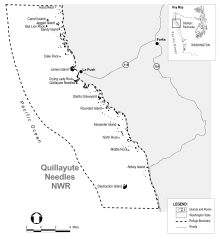
Washington Maritime National Wildlife Refuge Complex
Washington Maritime National Wildlife Refuge Complex is an administrative grouping of six National Wildlife Refuges in Washington, managed by the United States Fish and Wildlife Service. It includes:

- Flattery Rocks National Wildlife Refuge (125 acres (51 ha),[1] 48°10′N 124°44′W / 48.17°N 124.73°W[2])
- Quillayute Needles National Wildlife Refuge (300.2 acres (121.5 ha),[1] 47°49′N 124°30′W / 47.81°N 124.50°W)
- Copalis National Wildlife Refuge (60.8 acres (24.6 ha),[1] 47°24′N 124°20′W / 47.40°N 124.33°W[3])
- Dungeness National Wildlife Refuge (772.52 acres (312.63 ha))[1]
- Protection Island National Wildlife Refuge (659.31 acres (266.81 ha))[1]
- San Juan Islands National Wildlife Refuge (454 acres (184 ha))[1]
Washington Islands Wilderness refuges
Flattery Rocks, Quillayute Needles, and Copalis are a group of 870 islands, rocks, and reefs extending for more than 100 miles along Washington's coast from Cape Flattery to Copalis Beach. These islands are protected from human disturbance, yet are close to abundant ocean food sources.[4] They make up the Washington Islands Wilderness[5] and are closed to the public, with wildlife observation only from boats and the mainland, and a 200-yard buffer zone surrounds each island.[6] Only Tatoosh Island, James Island, and Destruction Island are not included in the wilderness area, which was established in 1970.[7] The wilderness has a total land area of 1.8 square kilometres (0.69 sq mi) covering over 780 square kilometres (300 sq mi) of ocean.

More than a million seabirds, waterfowl, and shorebirds may live on the islands during migration season. Breeding colonies of 14 species of seabirds use these rocks to raise their young. Mammals that live near the islands include sea lions, harbor seals, sea otters, and whales.[3]

These three lie within the boundary of Olympic Coast National Marine Sanctuary (National Oceanic and Atmospheric Administration). Along with nearby Olympic National Park the three agencies cooperate on research programs and other issues that may have impacts on the resources.[8]

The refuges were originally created as Flattery Rocks Reservation, Quillayute Needles Reservation, and Copalis Rock Reservation on October 23, 1907, by executive orders from Theodore Roosevelt. They were renamed by a presidential proclamation on July 25, 1940.[9] Flattery Rocks encompasses the islands off the Washington coast between latitudes 48° 02′ North and 48° 23′ North,[10] Quillayute Needles those between latitudes 47° 38′ North, and 48° 02′ North,[11] and Copalis those between latitudes 47° 08′ North, and 47° 29′ North.[12] James Island was removed from Quillayute Needles in 1966 and returned to the Quileute when the island was discovered to be part of the Quileute Indian Reservation.[13]

-
Point of Arches, Flattery Rocks
-
Quillayute Needles
-
Copalis Rock from Roosevelt Beach
-
Flattery Rocks map
-
Quillayute Needles map
-
Copalis map
Climate
| Climate data for Washington Maritime National Wildlife Refuge Complex | |||||||||||||
|---|---|---|---|---|---|---|---|---|---|---|---|---|---|
| Month | Jan | Feb | Mar | Apr | May | Jun | Jul | Aug | Sep | Oct | Nov | Dec | Year |
| Mean daily maximum °F (°C) | 47 (8) |
47 (8) |
49 (9) |
51 (11) |
55 (13) |
58 (14) |
60 (16) |
61 (16) |
60 (16) |
55 (13) |
51 (11) |
47 (8) |
53 (12) |
| Mean daily minimum °F (°C) | 40 (4) |
39 (4) |
41 (5) |
43 (6) |
47 (8) |
50 (10) |
53 (12) |
53 (12) |
51 (11) |
47 (8) |
43 (6) |
40 (4) |
46 (8) |
| Average precipitation inches (mm) | 15.1 (380) |
9.5 (240) |
10.6 (270) |
7.3 (190) |
3.6 (91) |
2.8 (71) |
1.7 (43) |
2.3 (58) |
3.6 (91) |
10.1 (260) |
14.5 (370) |
13.6 (350) |
94.7 (2,414) |
| Source: U.S.Prism[14] | |||||||||||||
See also
References
- ^ a b c d e f "Annual Report of Lands as of September 30, 2013" (PDF). United States Fish and Wildlife Service.
- ^ "Flattery Rocks National Wildlife Refuge". Geographic Names Information System. United States Geological Survey, United States Department of the Interior.
- ^ "Copalis National Wildlife Refuge". Geographic Names Information System. United States Geological Survey, United States Department of the Interior.
- ^ "Flattery Rocks National Wildlife Refuge Profile". U.S. Fish and Wildlife Service.
- ^ "Wilderness.net: Washington Islands Wilderness". Retrieved 2019-08-27.
- ^ "About the Refuge". Flattery Rocks National Wildlife Refuge. U.S. Fish and Wildlife Service.
- ^ "Wilderness Connect". wilderness.net. Retrieved 2019-08-27.
- ^ "Flattery Rocks National Wildlife Refuge - Wildlife and Habitat". 2012-11-13. Archived from the original on 2012-11-13. Retrieved 2019-08-27.
- ^ Proclamation 2416, July 25, 1940. Mentioned in the citations in the National Wildlife Refuge Administration Act.
- ^ Executive Order 703, October 23, 1907.
- ^ Executive Order 705, October 23, 1907.
- ^ Executive Order 704, October 23, 1907.
- ^ Removed by Public Land Order 4095, September 19, 1966, according to Comprehensive Conservation Plan/Environmental Assessment, Chapter 1, page 1-8.
- ^ [1] U.S. Climate Data. Retrieved April 29, 2022.
![]() This article incorporates public domain material from websites or documents of the United States Fish and Wildlife Service.
This article incorporates public domain material from websites or documents of the United States Fish and Wildlife Service.

External links
- Washington Maritime National Wildlife Refuge Complex
- Flattery Rocks National Wildlife Refuge U.S. Fish and Wildlife Service
- Quillayute Needles National Wildlife Refuge U.S. Fish and Wildlife Service
- Copalis National Wildlife Refuge U.S. Fish and Wildlife Service
- Washington Islands Wilderness
See what we do next...
OR
By submitting your email or phone number, you're giving mschf permission to send you email and/or recurring marketing texts. Data rates may apply. Text stop to cancel, help for help.
Success: You're subscribed now !






